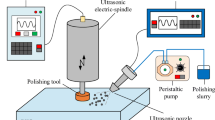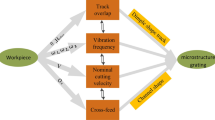Abstract
To solve the problem of fast convergence in large aperture plane optics continuous polishing, the concept of vibration-assisted polishing is proposed in this paper. The paper first builds a low-frequency short-range vibration processing platform based on large-size polishing tools. Then, the kinematics and polishing pressure of the optics without vibration and vibration are analyzed. Furthermore, the pressure distribution under the element is simulated based on the finite element method. Finally, the material removal rate (MRR) is calculated based on Preston equation, which proves that the removal rate of optics under vibration condition is higher. In this paper, the problem of optics removal efficiency in continuous polishing is solved and the material enhanced removal mechanism is revealed.












Similar content being viewed by others
References
Spaeth ML, Wegner PJ, Suratwala TI, Nostrand MC, Bude JD, Conder AD, Folta JA, Heebner JE, Kegelmeyer LM, Macgowan BJ (2016) Optics recycle loop strategy for nif operations above UV laser-induced damage threshold. Fusion Sci Technol 69(1):265–294
Suratwala TI, Feit MD, Steele WA (2010) Toward deterministic material removal and surface figure during fused silica pad polishing [J]. J Am Ceram Soc 93(5):1326–1340
Zhang H, Shao J, Xu X, Wu L, Yang M (2017) Analysis and optimization of surface profile correcting mechanism of the pitch lap in large-aperture annular polishing. Optifab 2017
Liao D, Ren L, Zhang F, Wang J, Qiao X (2018) Kinematic model for material removal distribution and surface figure in full-aperture polishing. Appl Opt 57(4):588–593
Nelson DG, Light B, Savage D, Wiederhold R, Mandina M (2010) VIBE™ finishing to remove mid-spatial frequency ripple. Optical Fabrication and Testing 2010
Chen S, He D, Yi W, Chen H, Chen Y (2016) Analysis of the convergence rules of full-range PSD surface error of magnetorheological figuring KDP crystal. Appl Opt 55(28):8056–8062
Ren L, Zhang F, Liao D, Zhao S, & Xie R (2019) Theoretical model and experimental analysis of non-uniform material removal during full-aperture polishing. Int J Adv Manuf Technol, 101.
Yin S, Shinmura T (2004) A comparative study: polishing characteristics and its mechanisms of three vibration modes in vibration-assisted magnetic abrasive polishing. Int J Mach Tool Manu 44(4):383–390
Guo J, Kum CW, Au KH, Tan ZE, Wu H, Liu K (2016) New vibration-assisted magnetic abrasive polishing (VAMAP) method for microstructured surface finishing. Opt Express 24(12):13542–13554
Li Y, Wu Y, Zhou L, Fujimoto M (2014) Vibration-assisted dry polishing of fused silica using a fixed-abrasive polisher. Int J Mach Tool Manu 77:93–102
Yang L, Brinksmeier E, Riemer O, Namba Y, Walker DD, & Schulte H, et al. (2010) Material removal mechanisms in abrasive vibration polishing of complex molds. Proc Spie, 7655, 765502-765502-6.
Zhang C, Zhao H, Zhu X, Zhao S, Jiang C (2018) Design of an ultraprecision computerized numerical control chemical mechanical polishing machine and its implementation. Opt Eng 57(1):015104.1–015104.10
Liao D, Xie R, Sun R, Zhao S, Ren L, Zhang F, Wang J, Qiao X (2018) Improvement of the surface shape error of the pitch lap to a deterministic continuous polishing process. J Manuf Process 36:565–570
Cooke F, Brown N, Prochnow E (1976) Annular lapping of precision optical flatware. Opt Eng 15(5):407–415
Preston FW (1927) The theory and design of plate glass polishing machines. JSocGlass Tech
Liao D, Zhang F, Xie R, Zhao S, Xu Q (2020) Deterministic control of material removal distribution to converge surface figure in full-aperture polishing. J Manuf Process 53:144–152
Acknowledgements
I am grateful to CAEP for providing experimental conditions and financial support.
Funding
The funding agency is the Science Challenge Project (No. JCKY2016212A506-0501; TZ2016006-0501-01).
Author information
Authors and Affiliations
Contributions
YW and FZ contributed the central idea, analyzed most of the data, and wrote the initial draft of the paper. The remaining authors contributed to refining the ideas, carrying out additional analyses, and finalizing this paper.
Corresponding author
Ethics declarations
Conflict of interest
The authors declare no competing interests.
Additional information
Publisher’s note
Springer Nature remains neutral with regard to jurisdictional claims in published maps and institutional affiliations.
Rights and permissions
About this article
Cite this article
Zhang, F., Wang, Y., Liao, D. et al. The optic material removal rate improved by vibration assistance in continuous polishing. Int J Adv Manuf Technol 117, 3075–3082 (2021). https://doi.org/10.1007/s00170-021-07806-9
Received:
Accepted:
Published:
Issue Date:
DOI: https://doi.org/10.1007/s00170-021-07806-9




